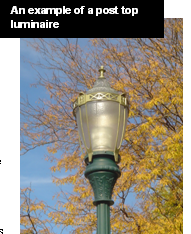§ 17.40.050. General standards.
A.
Illumination level at property boundary line. When a commercial or industrial use abuts a residential use, lighting shall be designed so that the illumination at the property boundary line that is attributable to the subject property does not exceed three tenths (0.3) foot-candles. When a commercial or industrial use abuts a public right-of-way, or another commercial or industrial use, lighting shall be designed so that the illumination at the property boundary line does not exceed one (1.0) foot-candles.
B.
Lighting required. Lighting shall be provided to illuminate sidewalks or other pedestrian paths, primary building entrances, and parking areas.
C.
Pole-mounted luminaires. Luminaires shall not be taller than twenty (20) feet in residential zoning districts or when placed within fifty (50) feet of a residential zoning district. In all other zoning districts, luminaires shall not be taller than thirty (30) feet.
D.
Building-mounted luminaires. In non-residential zoning districts, building-mounted luminaires shall not be attached to a sloped roof and shall not be taller than thirty (30) feet or the height of the principal building, whichever is less. The use of wall-pack luminaires is discouraged.
E.
Overhead electrical lines prohibited. For new installations, electrical lines for luminaires mounted on freestanding poles shall be placed underground between poles.
F.
Material for light poles. Light poles shall be anodized, painted or otherwise coated so as to minimize glare from the light source.

G.
Placement in buffer areas. Lights may not be placed in buffer areas that may be required by this Title, except for low-level lights for security purposes as approved by the City.
H.
Continued maintenance. Lighting installations shall be maintained in good repair to meet the provisions of this chapter on an on-going basis.
I.
Lighting curfew. For parcels with non-residential uses, lighting in vehicle parking areas containing twenty (20) parking spaces or more shall be reduced to fifty (50) percent of permitted levels one (1) hour after the business closing to one (1) hour before the business opens. If lighting levels are already below fifty (50) percent of permitted levels, no curfew adjustment is required.
J.
Luminaire types. Full-cutoff luminaires shall be used in parking areas, along internal streets, and along pedestrian ways. The City may allow cutoff luminaires or semi-cutoff luminaires in these locations when the overall uplight would be less than for full-cutoff luminaires. To promote a unified development theme, post top luminaires (also referred to as period lighting) may be used as an alternate if they have built-in reflectors that effectively eliminate uplight. Except as provided in this chapter, all other luminaires shall be directed downward and the light source shall be shielded so that it is not visible from any adjacent property.
K.
Maximum average lighting levels. Average lighting levels shall not exceed the standards provided for in Exhibit 40-1. For those areas not specified, the Director of Planning and Community Development shall work with the applicant to set an appropriate level on a case-by-case basis in keeping with the intent of this chapter.
Exhibit 40-1. Maximum average light levels
Location Foot-candles At entries for residential, commercial, and industrial buildings 5.0 At loading areas (berths) associated with a commercial or industrial use 10.0 In parking areas for multi-family uses 3.0 In parking areas for non-residential uses 5.0 Along sidewalks and other pedestrian walkways 3.0 Under service station canopies 20.0 In general storage areas for commercial and industrial uses 8.0 In vehicular display areas 15.0 L.
Maximum uniformity ratio. In all parking areas and along sidewalks and other pedestrian walkways, an average to minimum uniformity ratio of 6:1 or better shall be maintained.
M.
Minimum color rendering index (CRI). In all parking areas and along sidewalks and other pedestrian walkways, lighting shall meet or exceed the minimum color rendering index as provided for in Exhibit 40-2.
Exhibit 40-2. Minimum color rendering index for parking areas and pedestrian ways
Minimum color
rendering index (CRI)Residential zoning districts 60 Central business core and central business periphery 60 Mixed-use zoning districts 60 Commercial zoning districts, except central business core and central business periphery 20 Industrial zoning districts 20
(Ord. No. 3056, § 1, 8-17-2010)

